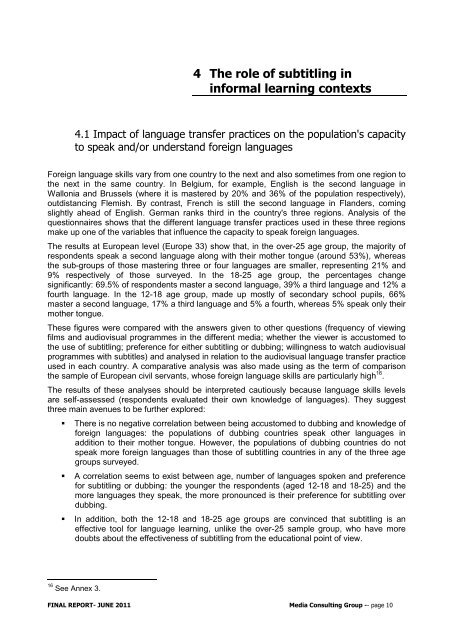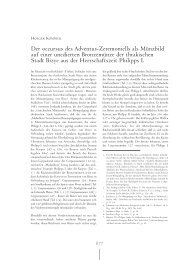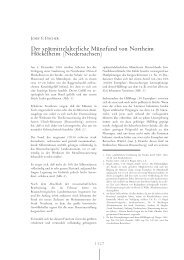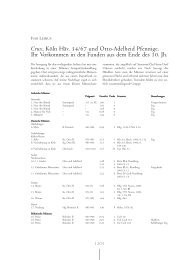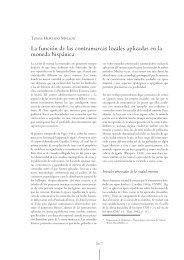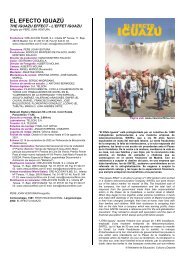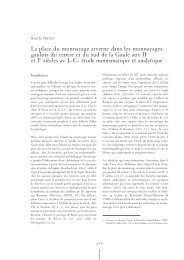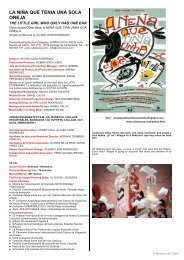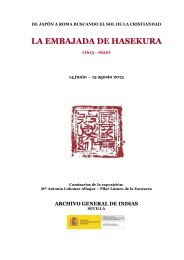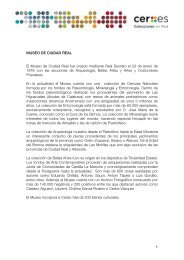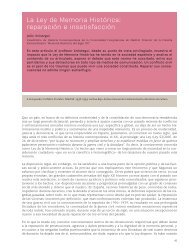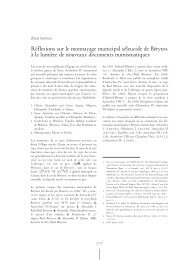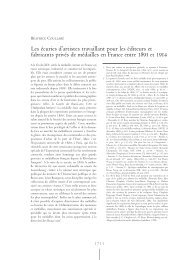Study on the use of subtitling
Study on the use of subtitling
Study on the use of subtitling
You also want an ePaper? Increase the reach of your titles
YUMPU automatically turns print PDFs into web optimized ePapers that Google loves.
4 The role <strong>of</strong> <strong>subtitling</strong> in<br />
informal learning c<strong>on</strong>texts<br />
4.1 Impact <strong>of</strong> language transfer practices <strong>on</strong> <strong>the</strong> populati<strong>on</strong>'s capacity<br />
to speak and/or understand foreign languages<br />
Foreign language skills vary from <strong>on</strong>e country to <strong>the</strong> next and also sometimes from <strong>on</strong>e regi<strong>on</strong> to<br />
<strong>the</strong> next in <strong>the</strong> same country. In Belgium, for example, English is <strong>the</strong> sec<strong>on</strong>d language in<br />
Wall<strong>on</strong>ia and Brussels (where it is mastered by 20% and 36% <strong>of</strong> <strong>the</strong> populati<strong>on</strong> respectively),<br />
outdistancing Flemish. By c<strong>on</strong>trast, French is still <strong>the</strong> sec<strong>on</strong>d language in Flanders, coming<br />
slightly ahead <strong>of</strong> English. German ranks third in <strong>the</strong> country's three regi<strong>on</strong>s. Analysis <strong>of</strong> <strong>the</strong><br />
questi<strong>on</strong>naires shows that <strong>the</strong> different language transfer practices <strong>use</strong>d in <strong>the</strong>se three regi<strong>on</strong>s<br />
make up <strong>on</strong>e <strong>of</strong> <strong>the</strong> variables that influence <strong>the</strong> capacity to speak foreign languages.<br />
The results at European level (Europe 33) show that, in <strong>the</strong> over-25 age group, <strong>the</strong> majority <strong>of</strong><br />
resp<strong>on</strong>dents speak a sec<strong>on</strong>d language al<strong>on</strong>g with <strong>the</strong>ir mo<strong>the</strong>r t<strong>on</strong>gue (around 53%), whereas<br />
<strong>the</strong> sub-groups <strong>of</strong> those mastering three or four languages are smaller, representing 21% and<br />
9% respectively <strong>of</strong> those surveyed. In <strong>the</strong> 18-25 age group, <strong>the</strong> percentages change<br />
significantly: 69.5% <strong>of</strong> resp<strong>on</strong>dents master a sec<strong>on</strong>d language, 39% a third language and 12% a<br />
fourth language. In <strong>the</strong> 12-18 age group, made up mostly <strong>of</strong> sec<strong>on</strong>dary school pupils, 66%<br />
master a sec<strong>on</strong>d language, 17% a third language and 5% a fourth, whereas 5% speak <strong>on</strong>ly <strong>the</strong>ir<br />
mo<strong>the</strong>r t<strong>on</strong>gue.<br />
These figures were compared with <strong>the</strong> answers given to o<strong>the</strong>r questi<strong>on</strong>s (frequency <strong>of</strong> viewing<br />
films and audiovisual programmes in <strong>the</strong> different media; whe<strong>the</strong>r <strong>the</strong> viewer is accustomed to<br />
<strong>the</strong> <strong>use</strong> <strong>of</strong> <strong>subtitling</strong>; preference for ei<strong>the</strong>r <strong>subtitling</strong> or dubbing; willingness to watch audiovisual<br />
programmes with subtitles) and analysed in relati<strong>on</strong> to <strong>the</strong> audiovisual language transfer practice<br />
<strong>use</strong>d in each country. A comparative analysis was also made using as <strong>the</strong> term <strong>of</strong> comparis<strong>on</strong><br />
<strong>the</strong> sample <strong>of</strong> European civil servants, whose foreign language skills are particularly high 16 .<br />
The results <strong>of</strong> <strong>the</strong>se analyses should be interpreted cautiously beca<strong>use</strong> language skills levels<br />
are self-assessed (resp<strong>on</strong>dents evaluated <strong>the</strong>ir own knowledge <strong>of</strong> languages). They suggest<br />
three main avenues to be fur<strong>the</strong>r explored:<br />
� There is no negative correlati<strong>on</strong> between being accustomed to dubbing and knowledge <strong>of</strong><br />
foreign languages: <strong>the</strong> populati<strong>on</strong>s <strong>of</strong> dubbing countries speak o<strong>the</strong>r languages in<br />
additi<strong>on</strong> to <strong>the</strong>ir mo<strong>the</strong>r t<strong>on</strong>gue. However, <strong>the</strong> populati<strong>on</strong>s <strong>of</strong> dubbing countries do not<br />
speak more foreign languages than those <strong>of</strong> <strong>subtitling</strong> countries in any <strong>of</strong> <strong>the</strong> three age<br />
groups surveyed.<br />
� A correlati<strong>on</strong> seems to exist between age, number <strong>of</strong> languages spoken and preference<br />
for <strong>subtitling</strong> or dubbing: <strong>the</strong> younger <strong>the</strong> resp<strong>on</strong>dents (aged 12-18 and 18-25) and <strong>the</strong><br />
more languages <strong>the</strong>y speak, <strong>the</strong> more pr<strong>on</strong>ounced is <strong>the</strong>ir preference for <strong>subtitling</strong> over<br />
dubbing.<br />
� In additi<strong>on</strong>, both <strong>the</strong> 12-18 and 18-25 age groups are c<strong>on</strong>vinced that <strong>subtitling</strong> is an<br />
effective tool for language learning, unlike <strong>the</strong> over-25 sample group, who have more<br />
doubts about <strong>the</strong> effectiveness <strong>of</strong> <strong>subtitling</strong> from <strong>the</strong> educati<strong>on</strong>al point <strong>of</strong> view.<br />
16 See Annex 3.<br />
FINAL REPORT- JUNE 2011 Media C<strong>on</strong>sulting Group -- page 10


